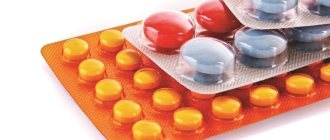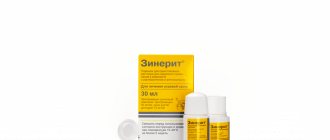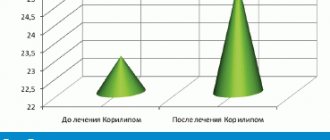Pharmacological properties of the drug Serrata
Pharmacodynamics. Serratiopeptidase is a proteolytic enzyme isolated from the non-pathogenic intestinal bacterium Serratia E15. Clinical studies have shown that serratiopeptidase has fibrinolytic, anti-inflammatory and anti-edematous effects. In addition to reducing inflammation, serratiopeptidase reduces pain by blocking the release of pain amines from inflamed tissues. Serratiopeptidase binds in a 1:1 ratio to blood α2-macroglobulin, which masks its antigenicity but retains enzymatic activity. Serratiopeptidase slowly penetrates into the exudate at the site of inflammation and its level in the blood gradually decreases. By hydrolyzing bradykinin, histamine and serotonin, serratiopeptidase reduces capillary dilatation and controls capillary permeability. Serratiopeptidase blocks plasmin inhibitors, thus promoting the fibrinolytic activity of plasmin. By reducing swelling and improving microcirculation, serratiopeptidase promotes mucus separation. Pharmacokinetics. The drug passes through the stomach unchanged and is absorbed in the intestines. Serratiopeptidase is detected in small amounts in the urine.
Serrata manufacturer's instructions
Compound
active ingredient:
serratiopeptidase;
1 tablet contains serratiopeptidase 10 mg
Excipients:
lactose, corn starch, magnesium carbonate, sodium starch (type A), magnesium stearate, Opadry-YS-1-7027 coating * Opadry-ОY-Р-7171 coating **.
* — Opadry-YS-1-7027 coating: hypromellose, titanium dioxide (E 171), triacetin.
** — Opadry-ОY-Р-7171 coating: polyvinyl acetate phthalate, titanium dioxide (E 171), diethyl phthalate, stearic acid.
Dosage form
Film-coated tablets.
Basic physical and chemical properties:
round, biconvex tablets, enteric-coated, white.
Pharmacotherapeutic group
Medicines used for pathology of the musculoskeletal system. Enzymes.
ATX code M09A B.
pharmachologic effect
Serratiopeptidase is a proteolytic enzyme isolated from the non-pathogenic intestinal bacterium Serratia E15. It is characterized by fibrinolytic, anti-inflammatory and decongestant activity. In addition to reducing inflammation, serratiopeptidase reduces pain by blocking the release of pain amines from inflamed tissues.
Serratiopeptidase binds in a 1:1 ratio to blood α-2-macroglobulin, masks its antigenicity, but retains its enzymatic activity. Then gradually at the site of inflammation it turns into exudate and, accordingly, its level in the blood decreases.
Serratiopeptidase directly reduces the dilatation (expansion) of capillaries and controls their permeability through the hydrolysis of bradykinin, histamine and serotonin. Serratiopeptidase also blocks plasmin inhibitors, thus promoting the fibrinolytic activity of plasmin. Thanks to proteolysis of the structural proteins of sputum, it improves the rheological properties of sputum and promotes its discharge.
The enzymatic activity of the drug is 10 times higher than that of α-chymotrypsin. In the focus of chronic inflammation, serratiopeptidase helps reduce the level of inflammatory mediators of polypeptide nature (bradykinin), fibrin, but does not have a significant effect on proteins of the living organism, such as albumin and α- and γ-globulin.
The drug penetrates well into areas of inflammation, lyses necrotic tissues and their breakdown products, reduces hyperemia and accelerates the penetration and activity of antibiotics. The drug reduces the viscosity of saliva and nasal discharge, thereby facilitating their removal.
Pharmacokinetics
The drug passes through the stomach unchanged and is absorbed in the intestines. The drug is inactivated by gastric juice. The maximum concentration in blood plasma is reached after 1:00. Serratiopeptidase reaches the bloodstream in an enzymatically active form, is also excreted in an active form in the bile and is found in small amounts in the urine.
Indications
- Surgical diseases: sprains and ruptures of ligaments, fractures and dislocations, swelling caused by plastic surgery.
- Respiratory diseases: reduces the viscosity of sputum and facilitates clearance from the respiratory tract.
- Diseases of the ENT organs: facilitates the discharge of secretions from the paranasal sinuses.
- Skin diseases: acute inflammatory dermatoses.
- Diseases of the female genital organs and mammary glands: hematomas, congestion in the mammary glands.
Contraindications
- Hypersensitivity to serratiopeptidase or to any other component of the drug.
- Blood clotting disorder.
Interaction with other drugs and other types of interactions
When used simultaneously, the drug enhances the effect of anticoagulants (this combination of drugs should be used under medical supervision), accelerates the penetration of antibiotics and non-steroidal anti-inflammatory drugs into inflamed tissues.
Features of application
Since serratiopeptidase affects the blood coagulation system, the drug should be used with caution in the following conditions:
- threat of bleeding;
- bleeding disorders;
- taking anticoagulants;
- severe liver disease;
- severe kidney disease.
The drug contains lactose. If you have a known intolerance to certain sugars, you should consult your doctor before taking this medicine.
The ability to influence reaction speed when driving a vehicle or operating machinery
Does not affect.
Use during pregnancy or breastfeeding
The use of the drug during pregnancy and breastfeeding is not recommended due to the lack of clinical data.
Directions for use and doses
The drug is taken orally by adults. Take 1 tablet 2-3 times a day after meals.
The tablets should be swallowed without chewing, with one glass of water.
The maximum daily dose is 30 mg.
The dose and duration of treatment depend on the nature and dynamics of the pathological process and are determined in each case individually by the doctor.
Children
The drug should not be used in children due to the lack of clinical data.
Overdose
Symptoms:
nausea, vomiting, anorexia, epigastric discomfort, in some cases - bleeding and streaks of blood in the sputum.
Treatment:
therapy is symptomatic.
Adverse reactions
From the digestive system:
diarrhea, nausea, vomiting, anorexia, epigastric discomfort, abdominal pain.
From the respiratory system:
nosebleeds, sputum mixed with blood, acute eosinophilic pneumonia.
From the immune system:
hypersensitivity reactions.
From the skin:
skin rashes, itching, skin hyperemia.
Best before date
3 years.
Storage conditions
Store at a temperature not exceeding 25 ° C.
Keep out of the reach of children.
Package
10 tablets per strip; 1 strip in a cardboard box;
10 tablets per strip; 1 strip per cardboard box, 10 packs per box
10 tablets per strip; 3 strips in a cardboard box;
30 tablets in a blister or strip; 1 blister or strip in a cardboard package;
30 tablets per strip; 5 strips in a cardboard box.
Vacation category
On prescription.
Manufacturer
KUSUM HEALTHKER PVT LTD
Manufacturer's location and address of place of business
SP-289 (A), RIIKU Industrial area, Chopanki, Bhiwadi, get it. Alwar (Rajasthan), India
© Translation into Russian by the editorial team of apteka24.ua.
Source: “State register of medicinal facilities of Ukraine”, 2020.
Indications for use of the drug Serrata
Surgery : sports injuries, sprains and ruptures of ligaments, fractures and dislocations, postoperative swelling, and is also used if there is a risk of transplant rejection. Plastic surgery : reduces postoperative swelling, restores microcirculation at the site of transplant rejection. Upper respiratory tract diseases : reduces the viscosity of sputum, promotes better penetration of antibiotics. Diseases of the ENT organs : infectious diseases of the ear, sinusitis. Dermatology : acute dermatoses. Obstetrics and gynecology : the anti-inflammatory activity of the drug promotes the resorption of hematomas and reduces swelling of the mammary glands.
Similar drugs:
- Ibufen Oral suspension
- Meloflex Rompharm Solution for intramuscular administration
- Dollar () Oral tablets
- Ketanov Oral tablets
- Synmeton (SYNMETON) Oral tablets
- Novalgin Oral tablets
- Milistan Caplets
- Spasmalin Solution for injection
- Aspirin Oral tablets
- Incena Capsule
** The Drug Directory is intended for informational purposes only. For more complete information, please refer to the manufacturer's instructions. Do not self-medicate; Before starting to use Serrata, you should consult a doctor. EUROLAB is not responsible for the consequences caused by the use of information posted on the portal. Any information on the site does not replace medical advice and cannot serve as a guarantee of the positive effect of the drug.
Are you interested in the drug Serrata? Do you want to know more detailed information or do you need a doctor's examination? Or do you need an inspection? You can make an appointment with a doctor - the Euro lab is always at your service! The best doctors will examine you, advise you, provide the necessary assistance and make a diagnosis. You can also call a doctor at home . Euro lab clinic is open for you around the clock.
** Attention! The information presented in this medication guide is intended for medical professionals and should not be used as a basis for self-medication. The description of the drug Serrata is provided for informational purposes and is not intended for prescribing treatment without the participation of a doctor. Patients need to consult a specialist!
If you are interested in any other drugs and medications, their descriptions and instructions for use, information about the composition and form of release, indications for use and side effects, methods of use, prices and reviews of drugs, or you have any other questions and suggestions - write to us, we will definitely try to help you.
Special instructions for the use of Serrata
Since the drug affects blood clotting, it should be used with caution in patients with a risk of bleeding and with impaired clotting time, as well as in patients taking anticoagulants. In case of severe liver and kidney diseases, the drug is used with caution. Children. There is no experience of use in children, so the drug should not be used in this age group. Use during pregnancy or breastfeeding. There is no experience with the use of the drug during pregnancy and lactation, so it should not be used in such patients. The ability to influence reaction speed when driving vehicles or other mechanisms. There is no data regarding the negative effect of serratiopeptidase on reaction speed when driving vehicles or other mechanisms.
Serrata™ 10 mg No. 150 tablet p.o. solution/intestinal
Instructions for medical use of the drug SERRATATM Trade name SERRATATM International nonproprietary name No Dosage form Film-coated tablets, enteric, 10 mg Composition One tablet contains the active substance - serratiopeptidase 10 mg, excipients: lactose monohydrate, corn starch, light magnesium carbonate, sodium starch glycolate, magnesium stearate, shell composition: coating Opadry YS-1-7027 white (titanium dioxide, hypromellose, triacetin), Opadry OY-P-7171 white (diethyl phthalate, titanium dioxide, stearic acid, polyvinyl acetate phthalate), purified water, alcohol isopropyl, methylene chloride. Description Round, biconvex tablet, enteric-coated, white. Pharmacotherapeutic group Other drugs for the treatment of diseases of the musculoskeletal system. Enzyme preparations. ATC code M09 AB Pharmacological properties Pharmacokinetics The drug passes through the stomach unchanged and is absorbed in the intestine. Maximum plasma concentration is achieved after 1 hour. Serratiopeptidase is detected in small amounts in the urine. When prescribing a therapeutic dose of serratiopeptidase, it is not possible to study the pharmacokinetics due to the instability of the enzyme in the blood. Absorption can be studied when high doses are administered to volunteers. Serratiopeptidase in plasma is determined after oral administration at a dosage of 100 mg/kg, its peak concentration is detected after 30 minutes. and within 2 hours after administration, it is absorbed in the small intestine and circulates in the blood in the form of enzyme-like active forms. Pharmacodynamics The active substance of SerrataTM - serratiopeptidase, isolated from the non-pathogenic intestinal bacterium Serratia E15, is a proteolytic enzyme with fibrinolytic, anti-inflammatory and anti-edematous activity. In addition to reducing the inflammatory process, SerrataTM reduces pain by blocking the release of pain mediators from the site of inflammation. SerrataTM binds in a 1:1 ratio to blood alpha-2-macroglobulin, which masks its antigenicity but preserves its enzymatic activity. It slowly turns into exudate at the site of inflammation, and gradually its level in the blood decreases. By hydrolyzing bradykinin, histamine and serotonin, serratiopeptidase directly reduces capillary dilatation and permeability. SerrataTM blocks plasmin inhibitors, thereby increasing fibrinolytic activity. SerrataTM, due to proteolysis of the structural proteins of sputum, improves the rheological properties of sputum and promotes its discharge. Indications for use In complex therapy - sprains and ruptures of ligaments, fractures and dislocations (to reduce swelling and restore microcirculation at the site of injury) - diseases of the upper respiratory tract (to reduce the viscosity of sputum and facilitate its discharge) - diseases of the ENT organs: facilitates the discharge of secretions paranasal sinuses - dermatitis with pain - mastitis (for resorption of hematomas, reducing congestion in the mammary glands) Method of administration and dosage The drug is prescribed as part of complex therapy in a dose of 10 mg (1 tablet) 2-3 times a day after meals. The tablets should be swallowed without chewing with 1 glass of water. The maximum single dose is 10 mg. The maximum daily dose is 30 mg. The duration of treatment depends on the nature and dynamics of the pathological process and is determined individually by the doctor. Side effects Rarely - nausea - vomiting - anorexia - epigastric discomfort - diarrhea Very rarely - nosebleeds - sputum mixed with blood - skin rashes, itching, skin flushing - acute eosinophilic pneumonia - hypersensitivity reactions are possible in persons with individual intolerance to the components of the drug Contraindications - hypersensitivity to the components of the drug - gastric ulcer - pregnancy and lactation - childhood and adolescence up to 18 years For patients with bleeding disorders, impaired liver and kidney function receiving anticoagulant treatment, careful monitoring is necessary when prescribing serratiopeptidase. Drug interactions When used simultaneously, the drug enhances the effect of anticoagulants. Concomitant use of serratiopeptidase and carbamazepine leads to a decrease in serum concentrations, therefore, to a decrease in the effect of carbamazepine. Special instructions Since the drug affects blood clotting, it should be used with caution in patients with a risk of bleeding and impaired clotting time, as well as in patients who are taking anticoagulants. In case of severe liver and kidney diseases, the drug is used with caution. The drug should not be taken by patients with rare hereditary galactose intolerance, Lapp lactase deficiency or glucose-galactose malabsorption. Peculiarities of the drug's influence on the ability to drive a vehicle or operate potentially dangerous mechanisms. No effect. Overdose Symptoms: nausea, vomiting, anorexia, epigastric discomfort, blood in the sputum and bleeding. Treatment: symptomatic therapy. Release form and packaging 10 tablets in a contour-free packaging. One contour-free packaging together with instructions for medical use in the state and Russian languages in a cardboard box. 10 cardboard packages are placed in a cardboard box (10x10). 30 tablets in contour-free packaging. 1, 5 and 10 contour cellless packages together with instructions for medical use in the state and Russian languages are placed in a cardboard box. Storage conditions Store in a place protected from light, at a temperature not exceeding 25ºС. Keep out of the reach of children! Shelf life: 3 years Do not use after the expiration date indicated on the package. Conditions for dispensing from pharmacies By prescription Manufacturer Kusum Heltker Pvt. Ltd., SP 289 (A), Riiko Indl. Area, Chopanki, Bhiwadi (Raj), India Registration Certificate Holder Kusum Heltker Pvt. Ltd., India Address of the organization that accepts claims from consumers on the quality of products (products) in the territory of the Republic of Kazakhstan Representative office of the Kusum Care Pvt. Ltd.", India in the Republic of Kazakhstan, Almaty, Dostyk Ave., 117/6, tel/fax: 295-26-50; 295-26-55




